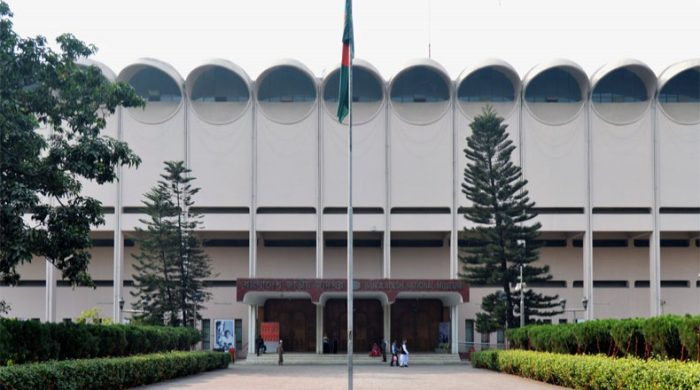When people are free, city venues close doors

- Update Time : Saturday, March 16, 2024
- 28 Time View

Most public city venues, including museums, antiquity and archaeological sites, turn away visitors after regular office hours, limiting scope for people to spend time with family and friends at the end of day’s bustle.
Experts emphasised rescheduling of visiting hours of these sites to accommodate the hectic lifestyle of the city’s over one crore residents against a backdrop of the changing socio-economic landscape.
‘It is time to reimagine the schedules of these places as the people’s life has become more income-oriented due to the sudden rapid economic transformation,’ said Professor Siddiqur Rahman, chairperson of the Department of Anthropology at Jahangirnagar University.
The Department of Archaeology and National Museum, both under the Ministry of Cultural Affairs, are the main custodians of antiquities and museums of the country.
The archaeology department oversees 547 sites and 21 museums across the country, while the National Museum, along with its eight branches, operates under the Ministry of Cultural Affairs.
Typically, all these sites and museums, owned and managed by the government, remain open from 10:00am to 5:00pm. On weekends, some of them stay open from 3:00pm to 7:00pm, or from 10:00am to 5:00pm with a one-and-a-half-hour break in between.
Besides, many playgrounds and parks, especially under the north city authority, are given lease to area-based community or society for maintenance.
The management committees of most of these playgrounds and parks, including the Iqbal Road park and field, have set time limit for entry for children and public.
The Ramna Park, situated at the heart of the capital, remains closed from 12:00 noon to 2:30pm every day.
Many mega cities, including Paris, Delhi, Istanbul, Tokyo, Shanghai, and New York, offer a variety of visiting hours depending on the specific attractions. Some spots in these cities even remain open to visitors round the week.
Md Tarikul and his wife, both employed, took a half-day leave on January 30 to visit the National Museum in the capital, with their two young children.
After a quick lunch and having their children readied, they set out and reached the venue about 4:10pm only to discover that the ticket counter closed their business for the day, as the museum remains open for visitors until 4:30pm.
Like Tarikul, many were observed to return disappointed from places, including the National Museum, the mausoleum of Kazi Nazrul Islam in Shahbagh, Lalbagh Fort in Old Dhaka, and Ahsan Manzil at Kumartoli along the bank of the Buriganga River.
‘So many places, particularly restaurants and shopping malls, remain open in Dhaka city at night. Places like museums could be open until at least 8:00pm,’ said Tarikul with frustration.
A security guard at the mausoleum of Kazi Nazrul Islam that closes at 4:00pm acknowledged that many return from the gates after the place is closed.
SM Rakibul Hasan and his four friends, all university admission candidates, reached the National Museum gate just after 4:00pm.
‘We planned this visit to gain more knowledge about the country’s history, heritage and culture,’ Raibul said, sad as they were returned from the gate.
‘In the morning, we are busy with our studies and other daily tasks. By the time we are free these places are closed. It would be helpful if the visiting times of these places are rescheduled,’ said Rakibul.
Due to haphazard urbanisation leading to a drastic reduction in open spaces like playgrounds and declining community life in cities, people have become more individualistic and reliant on social media for social interaction, said Zia Rahman, dean at the Faculty of Social Sciences at Dhaka University.
‘Times have changed. Traditional institutions like family have changed with more people coming into labour forces, and people’s mobility has increased with improved security, yet recreational centres remain inadequate,’ said the professor.
According to the annual report of the Cultural Affairs Ministry, in the fiscal year 2022–2023, 74.76 lakh people visited museums and archaeological sites under the Archaeology Department, while over four lakh people visited the National Museum during the same period.
‘With greater accessibility to these places, there is a high potential to increase the number of visitors and income derived from them,’ said Adil Mohammed Khan, executive director of the Institute for Planning and Development.
‘In mega cities like Dhaka people tend to be active until midnight and less occupied in the evenings. Thus, mega cities around the world keep flexible visiting hours for attractions, creating opportunities for people to socialise and connect with culture and history,’ the urban planner said, recommending keeping visiting places open after evening hours in Dhaka as well.
The Louvre Museum in Paris is open from 9:00am to 6:00pm from Monday to Sunday and extends its hours until 9:45pm on Fridays. The iconic Eiffel Tower welcomes visitors from 9:00am till midnight between June and early September and from 9:30am to 11:00pm for the rest of the year.
In Delhi, the famous Taj Mahal opens one hour before sunrise and closes approximately 45 minutes before sunset, except on Fridays. The Qutub Minar is accessible from 7:00am to 5:00pm every day.
Cultural affairs ministry secretary Khalil Ahmed mentioned that the ministry has been considering rescheduling visiting hours for these places, although no meetings have been held regarding this matter yet.
National Museum director general Md Kamruzzaman, however, said that they have been following the existing schedules for visitors for a long time and there is no plan to reschedule them.















